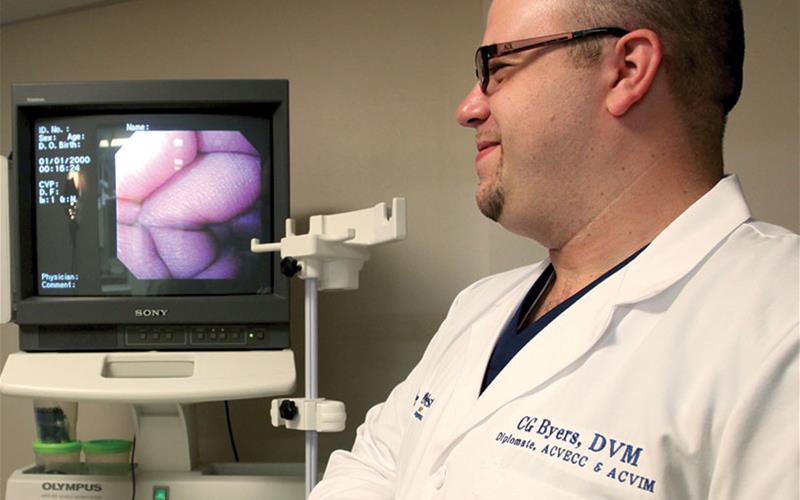Cystoscopy and Lithotripsy in Dogs and Cats

What is cystoscopy?
Cystoscopy is a procedure that allows specially trained veterinarians to look inside the urinary bladder and the urethra (tube connecting bladder to outside body) using a special instrument. Cystoscopy is endoscopy of the bladder and urethra performed with a thin lighted tube called a cystoscope. This procedure is performed in a sterile manner under anesthesia in dogs and cats. This procedure does not require an incision as the camera, scope and instruments are passed through the penis in males or the vulva in females.
Cystoscopy allows veterinarians to see areas of the bladder and urethra that do not show up well on x-rays or ultrasound imaging. Typically, a primary care veterinarian will refer a pet to a Board-certified Small Animal Internal Medicine Specialist for this procedure after full blood work, X-rays, urinalysis and urine cultures have been performed.
When would cystoscopy be needed?
Cystoscopy could be helpful to determine the cause of:
- Blood in the urine
- Urine leakage (urinary incontinence)
- Urinary blockages
- Complicated urinary tract infections
- When abnormalities in the bladder have been noted on radiographs (x-ray) or ultrasound
When needed, the veterinarian can insert tiny surgical tools for biopsy through the cystoscope. Some anatomic abnormalities can not only be identified but also corrected (if indicated) with small laser fibers through the cystoscope. This procedure may
avoid the need for more invasive surgery.
Is the use cystoscopy limited to size, gender or type of animal?
Cystoscopes can be either rigid (used in female animals) or flexible (used in male dogs). Cystoscopy is challenging in male cats (due to the very small urethra) but can be done with a very small scope or by accessing the bladder with a small surgical procedure and then the urethra is visualized through the bladder.
How long does the cystoscopy usually take?
Cystoscopy takes approximately 20 to 30 minutes depending on experience of the veterinary specialist performing the procedure, and the pet is typically sent home the same day.
What is lithotripsy?
Lithotripsy is the physical breaking of stones formed by the body within the urinary tract of cats and dogs. Lithotripsy is usually performed within the body using a laser fiber via surgery or cystoscopy with a shock wave applied to the stones.
When would lithotripsy be needed?
Lithotripsy can be helpful at treating:
- Bladder stones (in certain cases)
- Problematic kidney stones (causing infection, kidney damage, obstruction of urine flow)
- Urethral stones
What happens once the stones are broken?
- In the bladder, the stones are broken and removed with a small basket.
- Once kidney stones have been broken, a specialized wand is used to suction the large stone fragments. A stent (plastic tube) is then placed in the ureter to ensure flow of urine from kidney to bladder and avoid obstruction by small pieces of stone.
- Stones can also be removed from the urethra when they are stuck and causing issues with urination. This procedure is typically done with cystoscopy and use of a laser fiber through the scope so the veterinarian can see the stone, break it up and remove it during the same procedure.
The dog or cat is usually kept overnight for monitoring after the procedure but will not have incisions and often goes home the next morning.
...
Listen to an episode about Urinary Calculi (bladder stones) in Dogs on Morris Animal Health's Fresh Scoop podcast!
Edited By:
Paige Mackey, DVM, MPH, DACVIM (SAIM)
April, 2020
Articles by Specialty
- Cardiology (19)
- Large Animal Internal Medicine (23)
- Neurology (17)
- Oncology (21)
- Small Animal Internal Medicine (29)
Articles by Animal
- Cats (35)
- Dogs (52)
- Farm Animals (5)
- Horses (12)
